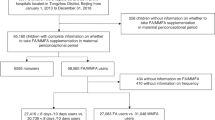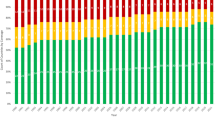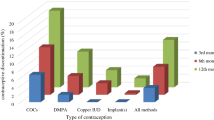Abstract
OBJECTIVE: There are some studies which analyzed the relationship between prenatal exposure to oral contraceptives (OCs) and Down syndrome, with conflicting results even in women using OCs and conceiving at different intervals after discontinuing the use of contraceptive pills. We analyzed the risk for Down syndrome in infants of women who become pregnant while taking OC.
STUDY DESIGN: We used the data from the Spanish Collaborative Study of Congenital Malformations (ECEMC). The ECEMC is a case–control study and surveillance system. For each malformed infant (case), the next non-malformed infant of the same sex born in the same hospital is selected as a control subject, from whom the collaborating physicians collected the same data as for the malformed infant. For the present study, we used two different approaches. First, the pair-matching analysis. Second, a case–control using the rest of the total of 17,183 controls from the ECEMC database with specified data on maternal use of OCs and maternal age. To control for maternal age, we used a logistic regression analysis.
RESULTS: The results show an increased risk of 2.8-fold for infants with Down syndrome in women younger than 35 years of age if the mother became pregnant while she was taking OCs. We did not observe this result for women older than 34 years of age.
CONCLUSION: Our results showed that the risk for Down syndrome in infants born to mothers with less than 35 years of age (as a group) who became pregnant while taking OCs is near the risk for Down syndrome of mothers with more than 34 years of age, women who are candidates for prenatal diagnosis. Thus, based on our results, one may consider the possibility of offering prenatal diagnosis for Down syndrome to young women who became pregnant while taking OCs.
This is a preview of subscription content, access via your institution
Access options
Subscribe to this journal
Receive 12 print issues and online access
$259.00 per year
only $21.58 per issue
Buy this article
- Purchase on Springer Link
- Instant access to full article PDF
Prices may be subject to local taxes which are calculated during checkout
Similar content being viewed by others
References
Ford JH Induction of chromosomal errors Lancet 1973 1 54
Lejeune J, Prieur M Oral contraceptive and trisomy 21. A retrospective study of 730 cases Semin Hosp 1979 55 1985–90
Read SG The distribution of Down's syndrome J Ment Defic Res 1982 26 215–27
Janerich DT, Flink EM, Keog MD Down's syndrome and oral contraceptive usage Br J Obstet Gynecol 1976 83 617–20
Ericson A, Källén B, Lindsten J Lack of correlation between contraceptive pills and Down's syndrome Acta Obstet Gynecol Scand 1983 62 511–4
Harlap S, Shiono PH, Ramcharan S, et al Chromosomal abnormalities in the Kaiser permanent birth defects study, with special reference to contraceptive use around the time of conception Teratology 1985 31 381–7
Källén B Maternal use of oral contraceptives and Down syndrome Contraception 1989 39 503–6
Mikkelsen M Epidemiology of trisomy 21: population, peri- and antenatal data Hum Genet 1981 (Suppl 2) 211–226 Cited by Yang Q, Sherman SL, Hassold TJ, et al. Risk factors for trisomy 21: maternal cigarette smoking and oral contraceptive use in a population-based case–control study. Genet Med 1999;1:80–8
Harlap S, Eldor J Births following oral contraceptive failure Obstet Gynecol 1980 55 447–52
Salvador J, Martínez-Frías ML Estudio epidemiológico del síndrome de Down en España Madrid: Ed Ministerio de Sanidad y Consumo 1989
Martínez-Frías ML, Bermejo E, Rodríguez-Pinilla E Diagnóstico clínico del síndrome de Down basado en 11 rasgos. Análisis epidemiológico de la especificidad de los rasgos estudiados An Esp Pediatr 1996 45 522–6
Martínez-Frías ML, Frías JL, Rodríguez-Pinilla E, et al Value of clinical analysis in epidemiological research: the Spanish registry experience Am J Med Genet 1991 41 192–5
Martínez-Frías ML Developmental field defects and associations: epidemiological evidence of their relationship Am J Med Genet 1994 49 45–51
Martínez-Frías ML, Rodríguez-Pinilla E, Bermejo E, Prieto L Prenatal exposure to sex hormones: a case–control study Teratology 1998 57 8–12
Janerich DT, Flink EM, Keogh MD Down's syndrome and oral contraceptive usage Br J Obstet Gynecol 1976 83 617–20
Yang Q, Sherman SL, Hassold TJ, et al Risk factors for trisomy 21: maternal cigarette smoking and oral contraceptive use in a population-based case–control study Genet Med 1999 1 80–8
Gaulden ME Maternal age effect: the enigma of Down syndrome and other trisomic conditions Mutat Res 1992 296 69–88
Van Blerkom J, Antczak M, Schrader R The developmental potential of the human oocyte is related to the dissolved oxygen content of follicular fluid: association with vascular endothelial growth factor levels and perifollicular blood flow characteristics Hum Reprod 1997 12 1047–55
Martínez-Frías ML Frecuencia al nacimiento de niños con síndrome de Down en España: análisis por años y por Comunidades Autónomas. Efecto del diagnóstico prenatal Prog Diagn Pren 1996 8 327–37
Martínez-Frías ML, Bermejo E Frecuencia basal de defectos congénitos en España y su evolución en el tiempo: utilidad y significado de las distintas cifras de frecuencia Med Clin 1999 113 459–62
Acknowledgements
We thank all the physicians who collaborated with the ECEMC in collecting the data.
Author information
Authors and Affiliations
Additional information
This work was supported, in part, by a grant from Instituto de Salud Carlos III, Ministerio de Sanidad y Consumo of Spain, and, in part, by Fundacin 1000 para la investigacin sobre defectos congnitos of Spain.
Rights and permissions
About this article
Cite this article
Martínez-Frías, ML., Bermejo, E., Rodríguez-Pinilla, E. et al. Periconceptional Exposure to Contraceptive Pills and Risk for Down Syndrome. J Perinatol 21, 288–292 (2001). https://doi.org/10.1038/sj.jp.7210538
Published:
Issue Date:
DOI: https://doi.org/10.1038/sj.jp.7210538
This article is cited by
-
Consider acne severity and potential risks when treating acne vulgaris in pregnant and breastfeeding women
Drugs & Therapy Perspectives (2014)
-
Altered incidence of meiotic errors and Down syndrome birth under extreme low socioeconomic exposure in the Sundarban area of India
Journal of Community Genetics (2014)
-
Treatment of Acne Vulgaris During Pregnancy and Lactation
Drugs (2013)



